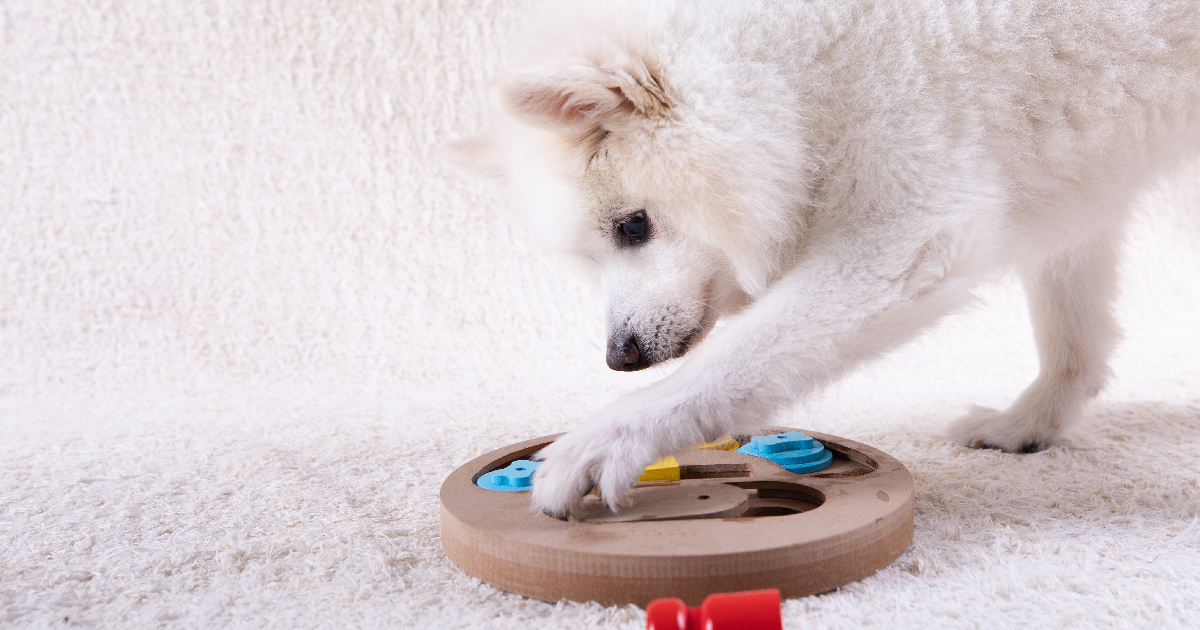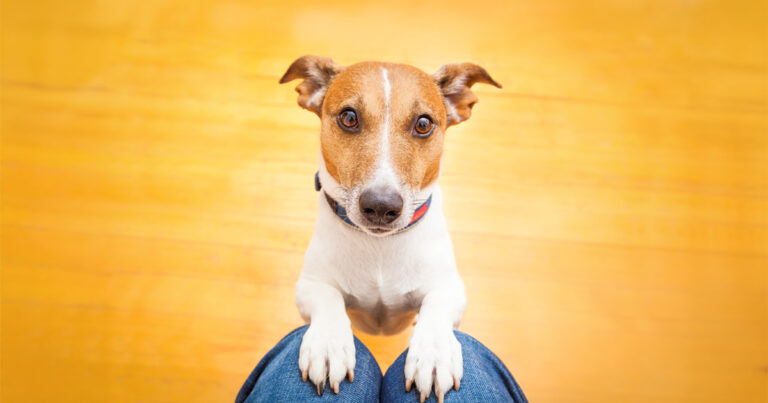A lot of focus is put on keeping your dog physically healthy. Things like making sure they get regular checkups, keeping them up-to-date on vaccinations and helping them maintain an ideal body condition are common topics that your veterinarian (and Diamond Pet Foods!) will remind you about to help make sure your dog stays healthy.
But there’s another part of your dog’s body that needs care as well — their mind. Just as you would exercise their muscles, your dog’s brain needs exercise, too. A whole month (May) is dedicated to raising awareness about the importance of mental health for people, and it’s a good reminder that your dog’s mental health is important, too.
The Problem with Boredom
Being home alone for hours on end with nothing interesting to play with is likely to lead to a bored dog. If you’ve ever been stuck in an airport by yourself waiting on a delayed flight, you understand how this feels. Bored dogs don’t have a phone to scroll through while they wait, so they tend to find their own entertainment — which is fun for them, but not so great for you when you come home to your house covered in fluff and toilet paper.
Naughty behaviors from a dog left alone shouldn’t be ignored, because as well as being frustrating for you, it could mean that your dog has separation anxiety, which can result in destructive behaviors or even aggression. Providing your dog with environmental enrichment can help stop your dog becoming bored and may help with separation anxiety.
Enrichment Should Mimic Normal Behavior
The Indoor Pet Initiative at Ohio State University tells us that environmental or behavioral enrichment reduces stress and promotes overall health by occupying time and increasing an animal’s perception of control over their environment. In other words, enrichment helps prevent dogs from becoming bored and lets them have a say in what their day looks like.
The Indoor Pet Initiative describes five categories that most environmental enrichment falls into: food-based, sensory (sight, smell, touch, hear, taste), novel objects, social and positive training. Enrichment activities should mimic the natural behaviors of dogs like stalking, hunting, catching prey, sniffing, digging, running and resting.
Puzzling Out Brain Exercise
Food puzzles are a great way to get your dog to exercise their brain. They need to use their problem-solving skills, and it takes up time in their day since a short meal turns into a long game. You can also make them “hunt” for their food by hiding the food puzzle instead of just handing it over. You can choose to put all of their daily food ration into a few different puzzles or you could do a small amount at a time. If your dog is up for the challenge, you can try puzzles that require multiple steps to be completed before the food is dispensed.
It’s best to take an allotment of their daily food and use that in the puzzle, so that they aren’t consuming extra calories. If you do use treats, make sure you don’t give your dog more than 10 percent of their daily calorie amount as treats, otherwise they might end up adding on a few pounds of weight while they’re exercising their brain.
A Change of Scenery Scratches the Enrichment Itch
Most people get a little antsy and bored when they’re stuck in the same house or apartment for days on end. It’s the same situation for your dog. Taking them out and about so they can see new sights, smell new scents and find new friends is a great way to care for your dog’s mental health.
But don’t just take them on a walk down the same street every day — mix it up! Walk a different path, take a hike on a new trail or visit your local pet store and pick out a new toy — anything that doesn’t make “going out” the same old routine. You could also arrange some off-leash play. It’s great for socialization and gives your dog’s sniffer a workout while they greet old and new friends.
If you’re running out of new spots to visit or you live in an area that doesn’t have a lot of walking options, you could try using a service like Sniffspot to find a new place to explore. Sniffspot helps you find private spaces to rent that provide off-leash enrichment for your dog and can help minimize distractions or triggers. Sniffspot also makes it easy to have playdates and socialize your dog in a controlled, private spot.
Does Your Dog Like Their Toys?
A variety of toys are a must for keeping your dog entertained — the same two or three toys all the time are probably going to lose their novelty pretty quick. That’s why it’s a good idea to have a basket full of toys (hidden away) that you can rotate through every few days. Different types of toys — squeaky, chewy, bouncy, smelly, plushy — can help keep the novelty of playing with toys going. Give your dog a few toys at a time and then replace them with another few from the toy basket after a few days. By the time you rotate back to the beginning, the original toys will feel almost new again for your dog.
However, one question to ask yourself is: Does your dog play with all of their toys, or are there some that sit on the floor and don’t move until you put them away? There’s no point having those toys in your toy rotation since your dog obviously isn’t interested in them. Instead, find the type of toys that your dog loves and fill the toy box with those.
Teach Your Dog New Tricks
No matter your dog’s age, you can get their mind working by teaching them some new tricks. Whether it’s upping their fetch game or learning some holiday-themed tricks they can master now to show off later, there are plenty of new skills your dog can learn. Plus, every dog could probably do with a brush-up on basic commands every now and then.
You could also introduce your dog to a new activity like a backyard agility course or a water sport. And living in a small space doesn’t mean your dog has to miss out on trying a fun activity. For example, you could build an indoor obstacle course with objects you have around your apartment.
There are lots of ways to keep your dog’s mind active and reduce the risk of boredom setting in. Some of them could be good for your mental health, too!
RELATED POST: The Five Most Common Reasons for Your Pet’s Behavior







